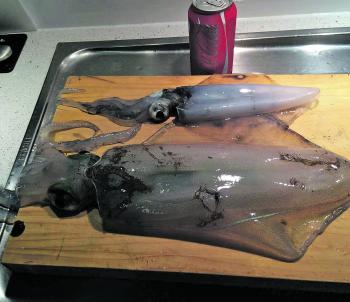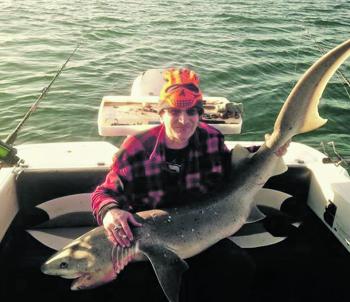Winter time on Phillip Island means extra jumpers, the occasional need for a rain coat and a little bit of thought when it comes to your fishing. It also requires a change to how you fish. Look more at the tides and wind direction. It’s colder at this time of the year and no one wants to be standing on a beach or sitting in a boat for hours, so concentrate more on that hour or two before and after the tides.
Study the weather a bit more as well. We are in the unique situation of having two islands, so it’s not often you can’t find a sheltered spot to make your fishing more enjoyable. I will be the first to admit the quantity of fish caught during the colder months isn’t great, but the quality is generally much better. We see more of the colder water species like draughtboard sharks, cod and ling. We also see every other species that you could expect to catch in the summer time.
There are several things you can do to have a successful fishing trip during the colder months and they are simple things that you should also do in summer. They seem to make a bigger difference over the colder months. Use fresh baits, present your baits correctly, position your boat on the drop-offs, fish the beaches on the gutter edges and fish the tides.
With a good run of salmon from the beaches lately several customers have been out collecting baits for the upcoming snapper season and to chase the winter gummies over the next few moons. This is a pattern that hasn’t changed over the time we have been in the shop.
The Kilcunda beaches are getting a build-up of weed with the windy conditions, making fishing frustrating at times. Perseverance generally pays off and there have been some quality 2kg models over recent weeks. The Woolamai beaches have been much cleaner and produce more fish.
These fish are smaller in size and are up to 1kg in weight. Both beaches have been successful for those using lures, especially if there is a lot of weed. White and silver are the best colours. Bluebait on a 2/0 or 3/0 O’Shaughnessy hook on a paternoster rig with a surf popper is the most popular combination and the one that has been working best.
I have had a few reports from other land-based spots. The Cowes and Newhaven jetties and the rocks at Smiths and Sunderland Bay have the fish, but not in the same numbers as the beaches.
Whiting customers that are thinking outside the box bring back a feed most times they head out. In Cleeland Bight it has been a battle between the whiting and the couta with the couta winning most times and ending the session. The smarter fishers haven’t just headed back to the ramp, they have gone to the San Remo side of the channel and near Footes where they have found quality whiting and very few couta.
The other spot where whiting have been caught from below the bridge is out the front of the Newhaven car park. Kayak customers have been successful off Cowes and Ventnor just fishing – as one customer said – a few paddles off the beach. The other areas worth trying over the next month or so are around the Bass River and the top channel light in the main channel at Newhaven.
During the cooler months try fishing deeper up to 10m for your whiting and use bigger hooks and baits. It works for many of my customers and just takes a bit of a change in your rig. A single paternoster rig with a long sinker and hook leader should do it. The best spot for those without a boat has been Sunderland Bay, on the low tide only, where I regularly see 40cm whiting caught.
Anglers picking the right days are managing quality flathead from offshore and this will continue right through winter. It’s getting favourable conditions that can be difficult. For some reason flathead stay in a lot closer during the winter months and can be found in 25-40m of water, generally closer to 25m, and just outside the eastern entrance. If you head offshore over this time of the year, have a rod ready with a lure setup, because you’ll see the odd school of salmon swim past.
Before you know it, the new season will be here and we will be talking about snapper again. Like all other species that we catch around the island, the odd reports will come in over winter too. We generally see at least one big snapper every week over the winter months. Lately it hasn’t been any different with the best just under the 8kg from the boats and 6.5kg from the jetty at Cowes.
Over the last few years many customers have left it too late to chase their snapper and missed out of the bigger fish, both land-based and boating. In recent years we have started getting reports as early as mid-August with the peak of the fish numbers in mid to late October. We have found that the pinkies have been moving in earlier and staying later, well into April.
Reads: 3693
Calamari will get better just in time for the snapper season.

Colder water means big, powerful sevengill sharks.




